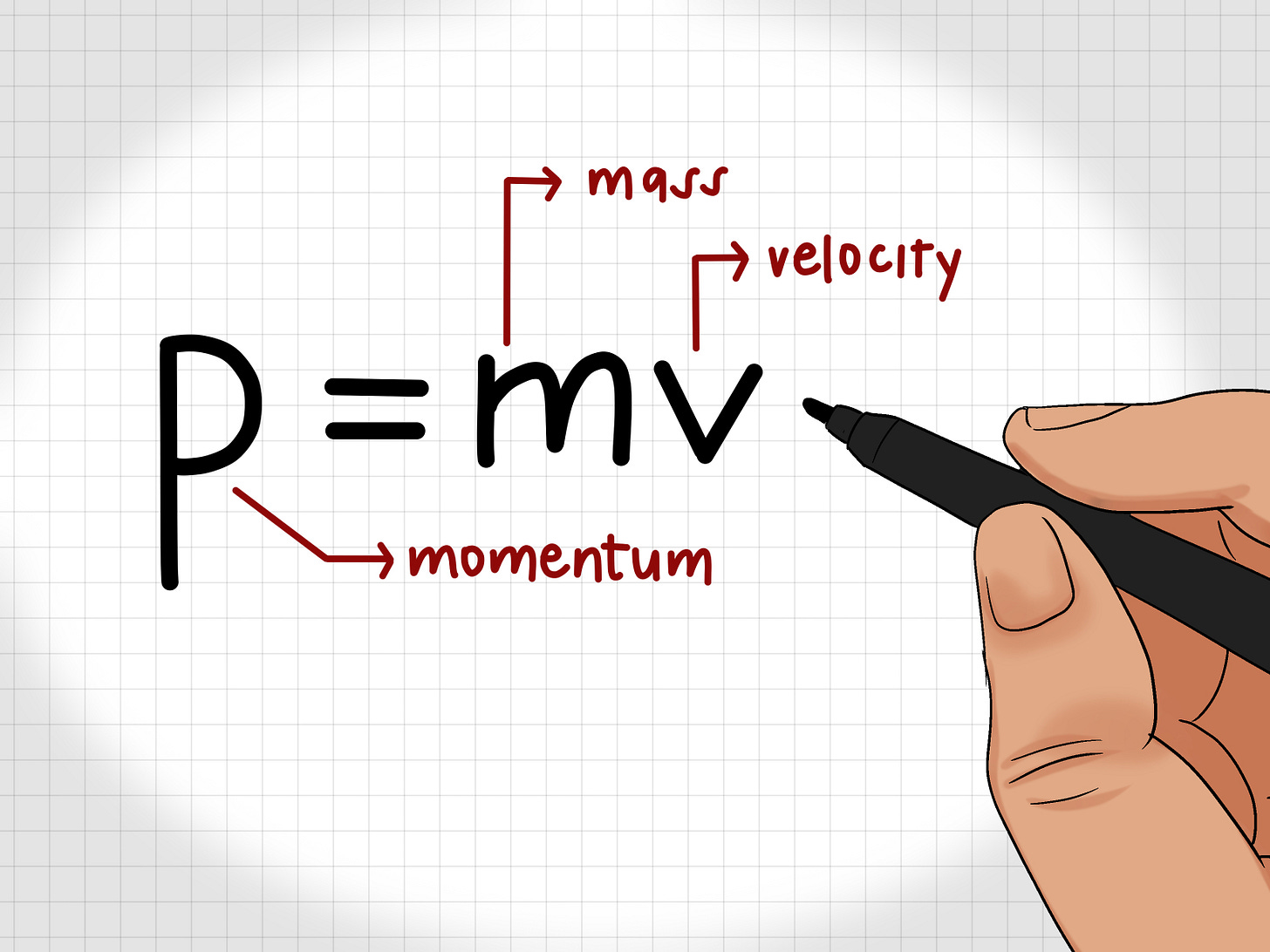It’s said the famous second law of Newton’s Laws of Motion was a derivation of momentum. You probably have heard of the word somewhere in your life, and while many people have either misunderstood it or simply don’t know, it affects almost everything that’s moving… and crashing into things.
Momentum is a quantity of motion, represented by the simple formula p = mv, where m is the scalar quantity mass of the object in motion, and v is the velocity of the object travelling at a certain speed and in a certain direction.
Momentum is conserved in an inertial frame of reference (FOR)- a closed system with no external force acting upon the object(s) in motion. Since it is conserved in inertial FORs, we can predict the resulting speed and directions that the objects in motion will travel in after a collision occurs between multiple moving objects.
Not to be confused with inertia (the tendency of moving objects to stay in motion or stopped objects to resist movement), momentum is simply a quantity of motion of a moving body. Momentum, as earlier described, is usually represented by the moving object’s mass times its velocity in a certain direction, and also has a relation with force. The change in momentum, also known as impulse, will equal to a constant force applied onto an object over a given period of time. Note: the force acting on the object must be constant! Or else this would not work.
Momentum is a key factor when it comes to solving problems regarding the collision between objects. There are two types of collisions: elastic and inelastic. During elastic collisions, momentum is conserved while momentum is not conserved during inelastic collisions. This is because inelastic collisions do not retain their initial kinetic energy: some might be lost to heat from friction or any other possible source. Most collisions in our real world are inelastic but most problems in physics classes will be elastic due to the simplicity of the situation (rejoice!). Here’s an example of an object colliding into another object with the same mass: momentum is transferred into the second box but it retains the same velocity because momentum is conserved!
Here we have a different scenario: an inelastic collision with two objects of different masses but moving towards each other at the same velocity. Why is this collision inelastic? Well, let’s take a look:
The conservation of momentum states that when a collision is elastic, all momentum will be conserved. So the sum of the initial momentum and final momentum must be equal. We started with 2mv + mv = 3mv, but ended up with ⅔ mv + 5/3mv = 7/3 mv at the end. Where did the missing momentum go? The kinetic energy of the blocks may have been lost due to friction or other factors affecting the blocks in motion.
Next, let’s look at a real life problem. For example, a truck and small car get into an accident and they crash. If the car was stationary, and the truck was speeding before it hit, the car would be either sent ‘flying’ or skid a large distance away. However, if their roles were reversed, the truck would only fall or even potentially only wobble at the impact of the car. It would take a lot more speed for the car’s momentum to have any effect on it. And as for the reason why, we can look to our awesome formula of the conservation of momentum: m1v1 = m2v2. Since the truck has a much larger mass, the conserved momentum from the car’s initial momentum would only result in a low velocity for the truck, if any, for it to even move. Now, you might ask: why doesn’t the car move back when it hits the truck if the truck has such a small velocity, like when a ball is bouncing back from a wall when thrown?
If we take a look at the first diagram shown above, we only have one mass moving in one direction! There is no momentum conserved in the other direction, so the truck could only tilt or move in the direction the car was moving in. However, if the truck was heading straight towards the car while it was also heading towards the truck, the car might be sent back some distance while the truck might just move a negligible distance back, similar to the second diagram shown.
Lastly, I have a special problem for you all reading, one that is still part of the debate amongst the scholars of r/PhysicsStudents:
Introducing: The Portal Paradox.
Now, many of you would obviously tell me that portals are not a thing. No, they are. Although the games and books depict them to be extremely convenient gateways to other places or perhaps another world, the portals in physics are more of a bending of space, aka wormholes. Anyways, There is a piston pushing downwards with velocity v, with a portal at its bottom. The piston would push through until it touches the black part of the table where a stationary block lies, and two scenarios are debated: scenario A, where the block plops out with no velocity, or scenario B, where the block flies out with velocity v, akin to the piston’s velocity when it slammed down.
How do both scenarios occur? Scenario A is assuming that the portal has no mass, and so when the portal (which is also the thing that comes into contact with the block) slams down and transports the block over, no momentum is transferred as there was no mass. (since m1v1 = m2v2, if one mass is zero, the other’s momentum is also zero) Scenario B argues that the momentum is still transferred as the piston comes to rest, and just because the portal has no mass does not mean that the momentum is conserved (similarly to how waves still have energy according to E = hν where as it doesn’t in E =mc2), and the block would fly out with the some velocity.
What do you guys think of this question? Whether your answer is right or wrong, it still makes it a good question to ponder and try to wrap your brain around it. The bending of space-time is a concept that many humans have difficulty understanding, similar to the concept of infinity, because we don’t expect it to happen in our daily lives. Note: I believe that in order for both scenarios to happen, the portal / wormhole must’ve given the block initial velocity to fall out of it in the first place. Or else B wouldn’t even happen and A would result in gravity pulling the block straight down, with half of it still in the portal due to the shape of the triangular ramp.
Momentum is an interesting concept in the most basic of all physics, and we can observe its influence on our surroundings at any given time. Next time you take note of the world’s actions around yourself, you might just find yourself looking at nature differently: an in depth constant analysis of how everything works can never be of harm to you.













